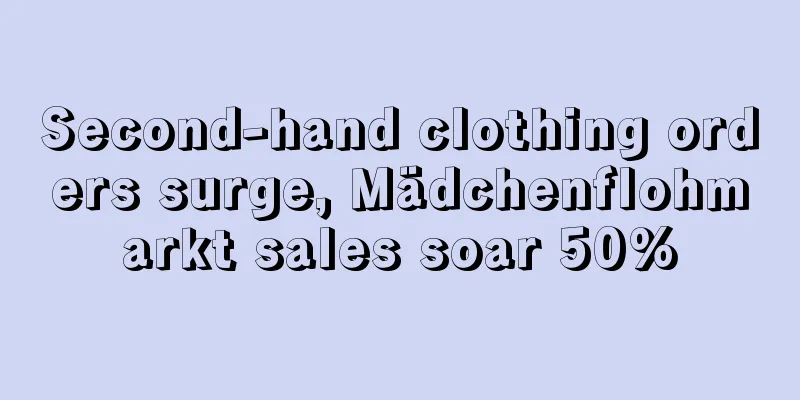Second-hand clothing orders surge, Mädchenflohmarkt sales soar 50%

|
During the epidemic, more and more second-hand merchants have turned their attention to the Internet , and both merchants and platforms can benefit from it. The transaction volume of second-hand clothing in Germany has increased significantly . According to the " 2020ubup Second-hand Fashion Report", two-thirds of German women have bought second-hand clothes .
Peter Ambrozy, co-founder of second-hand women's clothing platform Mädchenflohmarkt , said that compared with the previous year, the platform's sellers increased by 23% and sales increased by more than 30%, reaching a turnover of one million euros . Sales increased by 50% in the first quarter alone .
Peter Ambrozy added : "We expect to continue to grow this year, with sales continuing to grow by 60 to 80 percent. This goal was achieved in the first quarter due to the second lockdown ."
The epidemic has caused many workers to lose their jobs , forcing them to be frugal, which is the first driving force for promoting second-hand clothing transactions. In addition, the second largest growth driver is the concept of sustainable development .
The CEO of Rebelle, a second-hand clothing platform for big-name brands , believes that the epidemic has further increased people's awareness of new consumption patterns . What people need are fewer, higher-quality clothes that can be worn longer . The number of Rebelle registered users exceeded 2 million during the epidemic .
A Boston Consulting Group survey of customers of Vestiaire Collective , a second-hand luxury e-commerce platform , showed that 70 % of respondents said they bought second-hand fashion for sustainable development .
Some experts believe that 2020 is the peak of the German second-hand market, which is not an exaggeration. French second-hand platform Vinted plans to expand in Germany and is looking for developers, data scientists and product managers with experience in building global platforms. H&M's second-hand subsidiary Sellpy has also entered Germany.
In addition, Zalando has brought its second-hand platform Zircle to Sweden and Denmark. About You plans to add a second-hand column, where users can post their own second-hand items on the About You platform.
Experts speculate that the biggest potential in the German second-hand clothing market is seasonal surplus products. Currently , German fashion retailers are sitting on a large number of unsold clothes.
Given all this positive environment, Boston Consulting Group predicts a bright future for the German second-hand market. The company believes that the global market size for second-hand clothing, footwear and accessories is between $30 billion and $40 billion and is expected to continue to grow at an annual rate of 15%-20% within the next five years. Flea Market Sustainable Second-hand clothing |
<<: With over 67,000 products and over 500,000 users, Indonesia’s Ruparupa is gaining popularity
>>: South Korea's GS comprehensive online mall "Marketpo" is about to start trial operation
Recommend
Awesome! More than 1,000 pieces of inventory were suddenly abandoned, and the seller claimed compensation and got back 220,000 yuan
Competition on Amazon is getting more and more in...
What is Office Works? Office Works Review, Features
Established in 1994, Office Works is Australia'...
One piece sold in 5 seconds! Amazon's popular categories face both danger and opportunity
The industry is in decline and the market is nega...
What is Huayue International? Huayue International Review, Features
Huayue International (Shenzhen Huayue Internationa...
A large number of top sales executives are leaving the company
The trend of former senior executives of large co...
Sales surged 235%! Mother's Day is coming, and the British love to buy these...
British retailer Argos has both physical stores a...
With over 15 million views, DIY tufted carpet has become popular on TikTok!
Since the social platform TikTok was launched, it...
What is Wiser Solutions? Wiser Solutions Review, Features
Wiser Solutions Easy Access to Market Prices — Pr...
UK online grocery sales up 25% in April
Online grocery sales slowed significantly in Apri...
What is Amazon Operation? Amazon Operation Review, Features
Amazon agency operation actually helps merchants ...
What is windshop? windshop Review, Features
Windshop is a software that can track shipments se...
Chargers are really good! Dongguan 3C sales Aohai Technology sold 2.785 billion in one year
When it comes to 3C sales, many sellers will focu...
Amazon spends over 10 billion to acquire "Big Seller", facing antitrust investigation in the UK and the US
When Amazon announced its $1.7 billion (about 11....
BigCommerce Expands to France, Italy, and the Netherlands
In addition to Amazon, each European country also...
Amazon pledges to reduce plastic packaging in Germany
According to foreign media reports, US online ret...









